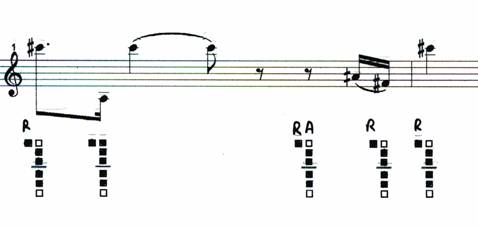| The Clarinet of the Twenty-First Century - E. Michael Richards |
DVD Movie
16) Composite Fingerings - Etude C Exercises
Etude C addresses composite fingerings: a set of fingerings that requires limited finger movement among 4 pitches and permits swift register leaps with minimal effort, while also providing a dramatic contrast in timbres. This etude presents fast rhythmic (changing meters) and dynamic contrasts among sets of 4 pitches for each of 10 composite fingerings. Slow practice and “chaining” will produce the quickest and most effective results.
The etude explores one composite fingering before seamlessly moving to the next (pitches that do not have fingering indications should be understood to be a continuation of fingerings presented earlier). Measure 1 through the fourth beat of measure 7 utilizes one composite fingering; the fourth beat of measure 7 through measure 12 uses another composite fingering.
In order to acclimate one's technique to these fingerings, the clarinetist should isolate each composite group and play the patterns in the etude slowly and in a regular rhythm by chaining beats together.
[The performance on the DVD demonstrates the fingerings alone, first – then the sound of each exercise.]
(Quicktime video - for free plug-in, click here)
Exercise #9

In the etude itself, the clarinetist can anticipate the next entrance by moving fingers early during the rests.
Exercise #10

The resistance of some of the high pitches (C quarter-tone sharp from m.13-9) requires careful setting of the embouchure, and a good memory of how the pitch will feel and sound. A fulcrum exercise can help accomplish this. The first measure below isolates the top pitches of 3 different composite fingerings (groups that follow each other in the etude) in order to allow the player to concentrate on the different resistance, color, and intonation of each. The clarinetist then applies these adjustments to measures 2-3 (taken from the etude itself).
Exercise #11

| |
||